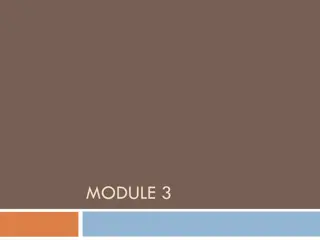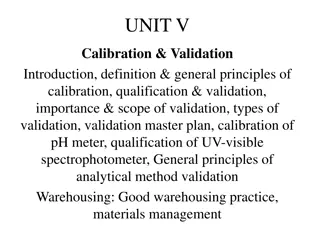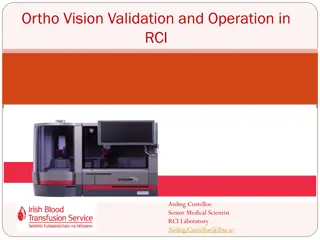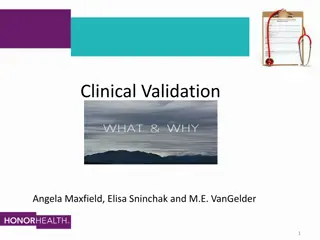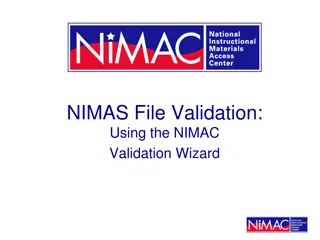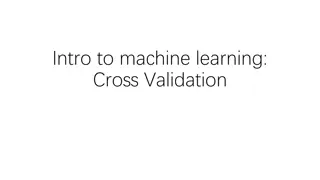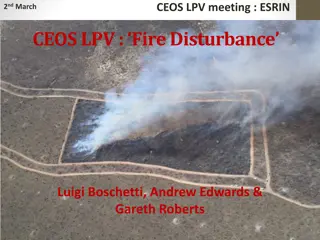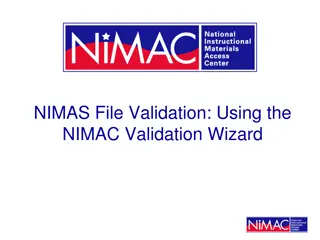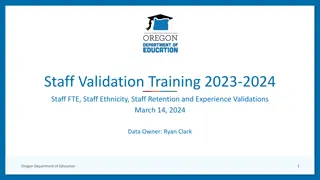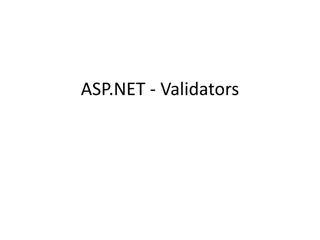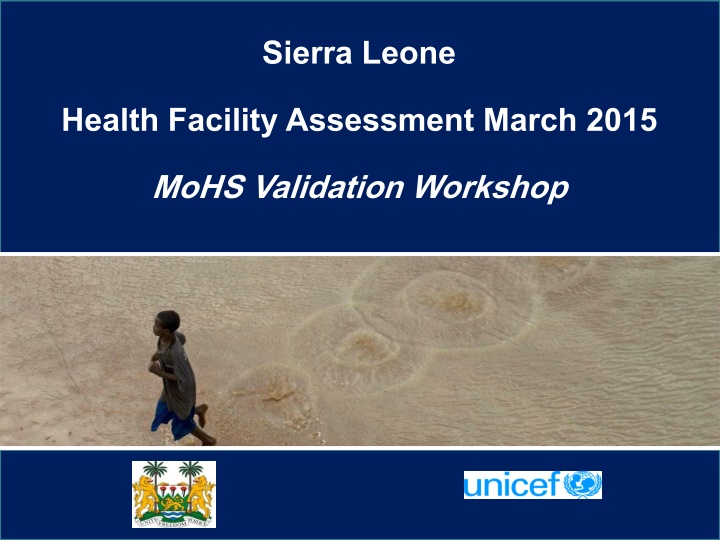
Health Facility Assessment in Sierra Leone: March 2015 Workshop Insights
Gain insights into the Health Facility Assessment in Sierra Leone through the evaluation of facility characteristics, utilization of maternal and child health services, program status, and Ebola-related challenges. Explore the objectives, methodology, and key findings concerning infrastructure, personnel, supplies, and MCH service coverage during the Ebola period.
Download Presentation

Please find below an Image/Link to download the presentation.
The content on the website is provided AS IS for your information and personal use only. It may not be sold, licensed, or shared on other websites without obtaining consent from the author. If you encounter any issues during the download, it is possible that the publisher has removed the file from their server.
You are allowed to download the files provided on this website for personal or commercial use, subject to the condition that they are used lawfully. All files are the property of their respective owners.
The content on the website is provided AS IS for your information and personal use only. It may not be sold, licensed, or shared on other websites without obtaining consent from the author.
E N D
Presentation Transcript
Sierra Leone Health Facility Assessment March 2015 MoHS Validation Workshop
OUTLINE 1. Overview of the Health Facility Assessment (HFA) 2015 2. PHU facility characteristics Functional Status of PHUs EVD Effect on human resources Status of supplies Infection prevention and control status 3. Utilization of MCH services 4. Program Status 5. EVD Related challenges
OBJECTIVES 1. Evaluate the status of PHU infrastructure, personnel and supplies during EVD period 2. Evaluate trends in maternal and child health (MCH) service utilization during EVD period 3. Gather additional programme information to inform health system recovery plans 4. Estimate changes in MCH service coverage during the Ebola period and model mortality impact
METHODOLOGY Site selection: All PHUs (1,185) Data collection: Round 1: October 2014 Round 2: March 2015 Northern 452 9 months of utilization data collected during the EVD epidemic (May 2014 Jan 2015) Eastern 287 Western 93 Southern 352 4-month (October-January) comparison periods Pre-Ebola (2013-14) compared to same 4 months during Ebola (2014-15)
Interview Teams: MoH & Focus 1000 (3-4 teams per district) METHODOLOGY Interviewed PHU in-charge or other health facility staff CHC, 257 , 22% Reviewed facility records and PHU registers for MCH data MCHP, 558 , 47% PHUs Surveyed by Type March 2015 Direct verification of stocks and infrastructure CHP, 369 , 31% Hard copy + Tablets used in 2nd survey GPS coordinates collected for over 70% of facilities
PHU characteristics during EVD Most PHUs are open Most health workers in service despite heavy losses Improved IPC readiness though gaps remain Many PHUs lack basic amenities (water, functional latrines, electricity, and refrigeration facilities) Drug stock out an issue Most PHUs are severely under-staffed
Most PHUs are Open & Functioning (98% open) Number of PHUs closed due to Ebola in March 2015 Only 24 out of 1,184 (2%) facilities were closed in March 2015 (compared to 47 in October 2014) 9 10 8 6 4 4 2 2 2 2 1 1 1 2 63% (15) of these were MCHPs (typically staffed by 1 or 2 health workers) 0 15 out of 24 were closed for less than 1 month Closed PHUs by facility type (March 2015) 2 70 (6%) of open facilities were closed for a period in the last 4 months MCHP 7 CHP 15 CHC Only 5 found closed in Oct were still closed in March
Heavy Losses of PHU Personnel to EVD Greatest Losses in Bombali, Port Loko and Moyamba Number of Health Personnel Deaths from EVD by District (Oct 14- March 15) Health Personnel EVD deaths at PHUs by Facility Type National Oct'14-March'15 Bombali, 35 No. of CHO/CHA who died, No. of nurses who died (SRN, midwives, SECHN), 19, 15% of deaths Port Loko, 26 124 Total Deaths Moyamba, 25 Other personne l who died, 71, 57% of deaths Bombali Port Loko Moyamba No. of MCH Aides who died, 27, 22% of deaths Koinadugu Kono WA Urban WA Rural Tonkolili Bo Kailahun Kenema Kambia Bonthe Pujehun
Improved IPC readiness at PHUs 39% of PHUs have a functional incinerator & 88% have a burning pit 99% have one or the other for safe medical waste disposal No. of PHU health personnel trained in IPC increased 2.6-fold from October 2014 to March 2015 (4,052 vs. 10,596) 98% of facilities report having a screening/triage station Access to Water remains a Concern 71% of PHUs have water at all times 14% of PHUs never have water Biggest gaps in: Tonkolili (35%) Pujehun (27%) Kambia (26%) Near universal availability of PPE items and chlorine/disinfectant Near universal availability of handwashing facilities: 90% at triage/screening station (Biggest gap: 65% in Port Loko) 75% overall in labour room (Biggest gap: 35% in Moyamba)
PHUs are Severely Understaffed MCH aides Standard: 2 at MCHP, 3 at CHP, 6 at CHHs 40% of MCHP have only one MCH aide CHPs are even more understaffed, with only 6% with the required 3 MCH aides. Less than 2% of CHC have the required 6 MCH aides Number of MCH aides by PHU 4% 100% 3% 15% 4% 3% 9% 26% 80% >=4 MCH aides 51% 60% 3 MCH aides 34% 2 MCH aides 40% 67% 1 MCH aides 42% 40% 20% 0 MCH aides 0% 0% 1% 0% CHC CHP MCHP
PHUs are Severely Understaffed SECHN Standard: 2+ SECHN in CHP, CHC Only 32% of CHP have 2 or more SECHN Only 58% of CHC are staffed with 2 or more SECHN. Number of SECHN by PHU 2% 100% 8% 2% 3% 17% 29% 7% 80% >=4 SECHN 6% 60% 3 SECHN 18% 2 SECHN 71% 79% 40% 1 SECHN 46% 20% 0 SECHN 2% 1% 8% 0% CHC CHP MCHP
Most Health Workers are still in Service despite Heavy Losses Number of MCH Aides working Pre- Ebola and During Ebola National Summary 1. Using MCH Aides as a proxy, limited evidence of health staff attrition across regions (Little change over time) 2500 2038 1978 1906 2. Nevertheless, total of 215 personnel abandoned posts 156 (73%) notably among the other personnel category 32 (15%) among MCH aides 22 (10%) nurses and 5 CHO/CHA (2%). 2000 1500 1000 500 0 Number working - April 2014 Number working - Oct 2014 Number working - March 2015
Distribution of CHWs at PHUs 97% of PHUs have CHWs 97% of PHUs have CHWs compared to 85% in Oct 2014 Median number of CHW per PHU : 11 75% of total increase from Oct due to PL roll out of CHWs programme since Oct 2014 Hard to reach population coverage of CHWs not known. Additional survey to be undertaken soon Below standard
Remaining Gaps in IPC Readiness Percentage of PHU Personnel Trained in IPC by cadres of personnel National (March 2015) All PHU Personnel (%) 84% Among PHU personnel 15% Midwives not trained 13%of Other health personnel not trained 27%of Other non- health personnel not trained Other non health 73% Midwives 85% Other health personnel 87% MCH aides 92% CHO 94% Lab techs/ assistants 94% CHA 95% SECHN 95% 0% 50% 100%
EVD Related Challenges Reported by PHUs PPE & Training no longer major concerns But fear of Infection and Stigma High Other major challenges reported by PHUs: Low turn out of patients due to patient fear coming to PHUs 90% 87% 72% 66% 37% 26% 23% NA for 2014 16% 15% 12% 11% Fear of being infected by patient Fear of being stigmatised by community Inadequate supply of medicine Inadequate supply of PPE Inadequate Information Inadequate training on Ebola 2014 2015
Majority of PHUs Lack Basic Amenities PHUs with Missing Basic Infrastructure National (March 2015) 66% of PHUs don t have electricity 60% of PHUs don t have a refrigerator to store vaccines 59% don t have 2 latrines 29% don t have water always available Inadequate access to water and latrine for the majority of PHUs No electricity 66% No functional incinerator 61% At least 2 latrines not available 59% No refrigerator for vacccine 60% Water not always available 29% No water (on-site or <50meters) 26% No burning pit 12% No safe medical waste disposal (burning pit or incinerator) 1%
Majority of Sites have Water but Availability is Variable Across Districts Percentage of PHUs where Water is Rarely or Never Available by District Water Availability at PHUs National 100% Tonkolili 48% Kailahun 40% 71% 80% Pujehun 39% Kambia 35% 60% Port Loko 29% Moyamba 28% WA Urban 40% 25% Kenema 23% 14% Kono 21% 12% 20% 4% WA Rural 17% Bombali 16% 0% Bo 11% Always available Often available Rarely available Never available Koinadugu 6% Bonthe 4% 75% of PHUs have water always or often available 26% have water rarely or never available Percentage of PHUs with water rarely or never available is highest (> 30%) in Tonkolili, Kailahun, Pujehun and Kambia
Availability of Water 62% of PHUs have water available from a water source on the ground or within 50 meters of the facilities Availability of water and distance to water 100 Total 75% Water source > 50m 80 IMPORTANT NOTE: Water Supply may be present but Water is not necessarily available Water source < 50m Percentage of PHUs % 12 60 Water source on site 9 Possible Reasons: Technical malfunction Well is dry If it is a piped system, the public water system is not distributing water continuously 40 53 20 13 6 5 0 Always / often available Never / Rarely available
41% of PHUs have Standard 2 Latrines Availability of Latrines at PHUs National (March 2015) 41% of PHUs have at least 2 latrines (standard) 1200 100% 94% 1000 80% 800 37% have latrines separated for females 60% 600 41% 37% 36% 40% 400 20% 200 1094 480 418 430 0 0% Any latrines At least 2 latrines Latrines for males-only Latrines for females-only
40% of PHUs have fully functional Refrigerators for Vaccines Nearly all facilities (99%) offer child immunisation services 38%don t have refrigerators Even where a refrigerator is available, 1/3 are not functional or partly so
Serious Stock Outs of Essential Medicines March 2015 Percentage of PHUs without Essential Medicines National (March 2015) Dexamethasone (Infant lung development if 48% Injectable gentamycin (Newborn sepsis) Infant/newborn 20% Amoxicilin tabs (pnemonia) 84% Albendazole/ mebendazole (de-worming) 45% Cotrimoxazole tabs (pnemonia) 34% Child Either Amoxicillin or Cotrimoxazole 32% Folic acid/ multi-vitamin (Fetal neural tube 62% Diazepam (Eclampsia if MgSO4 unavailable) 37% Oxytocin (Post-partem hemorrhage) 27% Maternal Magnesium Sulphate MgSO4 (Eclampsia) 14% Either Diazepam or MgSO4 (Eclampsia) 9% Ampiciline cloxacilin (Antibiotics) 84% Injectable benzylpenicilin (Antibiotics 71% Doxycyline/erythomycin (Antibiotics/Malaria) 57% Metronidazole (Antibiotics) 35% Antibiotics & ACT ACT Tablets (Malaria) 3% 0% 20% 40% 60% 80% 100%
Impact of EVD on Utilization of MCH Services Service uptake at PHUs declined significantly from May to Sept 2014, started recovering thereafter in majority of districts Trends coincide with both onset of rainy season and surge of Ebola and cannot be attributed to the EVD outbreak alone Comparing levels of MCH service utilisation Oct Jan 2014/15 (Ebola period) vs Oct Jan 2013/14 (non-Ebola period) Significant declines by 14% ANC, 17% Penta 3, deliveries 7% Largest and statistically significant decline in 4 districts most affected by ebola: Port Loko, Bombali, Western Area
Two Analyses to Measure Impact of EVD on MCH Service Utilization Analysis 1: Mapped changes in Service Utilization with changes in EVD epidemiology 4 Tracer Interventions were assessed: ANC4, Health Facility Deliveries, Penta3, U5 Malaria Treatment 9 month EVD period analysed (May 2014 Jan 2015) Analysis 2: Health Service Utilisation Levels were compared between Pre-Ebola period and During Ebola period Pre-Ebola Period: October 2013 Jan 2014 During Ebola Period: October 2014 Jan 2015
MCH Services Utilisation Trends during Ebola ANC4, Penta 3, and Institutional Deliveries (May 2014-Jan 2015) Visits to PHUs for ANC, Penta3, and deliveries: Declined since May 2014 Reached their lowest levels around September 2014 Started increasing thereafter
17% Reduction in Penta 3 Service Utilization Pre-Ebola (Oct 13-Jan 14) and During Ebola (Oct 14-Jan 15) Comparison 17% Decline in Penta3 vaccination Decline is large and statistically significant (-27%) in 3 districts most affected by Ebola: Port Loko, Bombali and Western Area -7% Small declines in Other Districts and not statistically significant
Drop in Utilization Levels much more Significant for Highly Ebola-affected Districts Percent change in number of visits during Ebola (Oct 2014-Jan 2015) vs pre-Ebola (Oct 2013- Jan 2014) Highly affected districts (Port Loko, Bombali, Western) Tracer MCH services at PHU level Non-highly affected Nationally districts ANC 4 -25% -9% -14% Penta 3 -27% -11% -17% Deliveries -19% 0% -7% U5 children treated for malaria -47% -27% -31% ANC4 Declined by 14% on average Largest and statistically significant decline by 25% in Port Loko, Bombali and WA Deliveries Declined by 7% on average Largest and statistically significant decline by 19% in PL, Bombali and WA
Different Trend & Significant Drop for U5 Malaria Treatment Figure 50. National: Number of U5 treated for malaria Oct-Jan 2014/15 vs Oct Jan 2013/14 U5 children treated for malaria 120000 2500 -31% The number of children treated for malaria declined by 31% 100000 2000 80000 1500 Equivalent to about 27,200 children not treated for malaria every month EVD cases 60000 1000 40000 Drop observed across all districts irrespective of the intensity and duration of the EVD outbreak. 500 20000 0 0 May Jun Jul Aug Sep Oct Nov Dec Jan EVD cases monthly 2013 2014
Estimated Impact of Changes in Service Utilisation on Child and Maternal Deaths using Lives Saved Tool (LiST) Mathematical Model Additional (non-EVD) Child Deaths Estimated (12 month Period) 1. Estimated Baseline Deaths with no EVD Impact (2014) 37,284 U5 Child deaths 10,851 Newborn deaths 2. Observed Reduction in MCH Services Utilisation during Ebola: ANC4: -14% Penta 3: -17% HF Deliveries: -7% U5 treated for malaria: -31% 3. If these trends continue for next 12 months, then: 7536 additional U5 deaths estimated (20% increase) 780 additional newborn deaths estimated (9% increase) 2628 deaths due to diarrhea 1825 due to pneumonia 60,000 +20% +25% 7,536 6,537 40,000 +9% 780 20,000 37,284 26,433 10,851 0 Total U5 deaths <1 month 1-59 months Estimated additional U5 deaths Baseline U5 deaths Causes of additional (non-EVD) child deaths 2628 1825 1483 998 601
Projected change in Sierra Leones 2014 under 5 mortality rate resulting from declines in MCH service utilisation during the EVD epidemic Sierra Leone s U5 Mortality Rate in 2013: 161 deaths per 1000 live births. 193 193 Estimated U5 mortality Rate in 2014 based on Model: 193 deaths per 1000 live births
Maternal & Newborn Health Services Significant declines in maternal & neonatal services in districts highly affected by EVD (PL, Bombali, Western) but not significant in other districts Critical lack of basic amenities and supplies to support safe child birth Large gaps also in BEmONC facilities
Impact of EVD on Maternal and Newborn Services at PHU level: ANC4, HF Deliveries, Postnatal Visits, & Family Planning Maternal Mortality Ratio1,100/100,000 Mothers have a 1 in 21 lifetime risk of deaths when giving birth Approximately 1,800 Maternal Deaths in 2013 Neonatal Deaths contributes to 25% of Under-five Mortality Highly affected Districts: WR, WU, PL, Bomb Non-highly affected districts (10)* ANC4 Delivery First Postnatal Visit Family Planning -27% -19% -18% -37% 0% -2% 1% -6% Highly Affected Districts by EVD: Significant Reductions in Utilisation observed Non-highly Affected Districts: Utilization levels not significantly affected
26% of PHUs had both Recommended Medicines for ANC Percentage of Facilities with ANC Essential Medicine (Package consists of Folic acid + Albendazole) Only 26% of PHUs had both drugs present in Facility National 26% PHUs by region Northern 14% Western 16% Eastern 27% Southern 44% 0% 20% 40% 60% 80% 100% Percentage of facilities with complete ANC package
44% of BEmONC Facilities had All 3 Essential Drugs Essential Drugs at BEmONC facilities National March 2015 Complete BEmONC Oxytocin MgSO4 Benzylpenicillin (Note: Calcium Gluconate is Missing from HFA Survey) 94% 100% 84% 80% 60% 48% 44% 40% 20% 0%
22% of PHUs had both Delivery Bed and Complete Delivery Kit Available Complete Delivery Kit Both Delivery Bed and complete Delivery Kit Available 100% 100% 80% 54% 54% 47% 60% 42% 39% 40% 80% 20% 0% NorthernEasternSouthern Western National 60% Percentage of PHUs with Standard Delivery Bed 40% 30% 22% 100% 20% 19% 18% 80% 20% 48% 60% 36% 35% 30% 29% 40% 20% 0% 0%
76% of PHUs can Ensure Referral within 3 hours 94%92%86%83%81% 80%76%71%68%64%62%60% 100% 76% 80% 60% 54%48% 40% 20% 0%
Percentage of PHUs with Family Planning Commodities in Stock (March 2015) Majority (93%) of PHUs had male condoms Only 58% had depprovera 98% 96% 100% 93% 92% 91% 90% 87% 87% 85% 83% 80% 66% 65% 58% 54% 60% 40% 29% 20% 0% Northern Eastern Southern Western National Oral Contraception Depoprovera contraception Male Condom
Percentage of PHUs that Offer/Recommend Newborn Care Services 99% of PHUs recommend breastfeeding within 1 hr after birth Skin-to-skin care 99% Breastfeeding within 1 hour of birth 99% Cord care (chlorhexidine) 92% Newborn eye care (tetracycline) 69% Vitamin K 61% 0% 20% 40% 60% 80% 100% 120%
Child Health Services Critical lack of essential child health drugs Distribution of medicines for iCCM and Malaria treatment declined during ebola, suggesting fewer cases were treated at the community-level Prevention of malnutrition significantly affected 28% reduction in number of children who attended growth monitoring programmes (Oct Jan 2014/15 vs Oct Jan 2013/14) Treatment of malnutrition affected by RUTF stockout despite RUTF distribution
Child health services offered by PHU Causes of Child Deaths in Sierra Leone (DHS 2013) Child health services surveyed in Health Facility Assessment: Treatment of childhood diseases Pneumonia 17% Other 30% Routine vaccination diarrhoea 13% Prevention and treatment of malnutrition Malaria 14% HIV/AIDS 1% Functionality of Integrated community case management (iCCM) Neonatal 25%
67% of PHUs had the Child Essential Medicines Package Child Health Essential Medicine Package (Package consists of ACT + Either Amoxicillin or Cotrimoxazole for pneumonia) National 67% Facilities by region Southern 48% Northern 74% Western 77% Eastern 82% 0% 20% 40% 60% 80% 100% Percentage of facilities with complete CH package
iCCM: CHWs received less supervision and less medicine distribution during Ebola PHUs with Supportive Supervision for CHWs Pre-Ebola and During Ebola 96% 95% 92% 90% 89% 89% 88% 84% 100% 78% 70% 50% 0% Northern Eastern Southern Western National With supportive supervision Pre Ebola (Oct'13-Jan'14) With supportive supervision During Ebola (Oct'14-Jan'15) iCCM: percentage of PHUs providing medicine to CHWs 86 100 81 79 78 74 71 70 65 56 54 50 0 Northern Eastern Southern Western National Percentage of PHU which provided any medicine to CHWs, May '14 to Sep '14 Percentage of PHU which provided any medicine to CHWs, Oct '14 - Jan '15
Prevention of malnutrition declined during the EVD outbreak Children Attending Growth Monitoring Programme Pre-Ebola and During Ebola 38% of children under 5 are stunted, including 49% among children 18-23 months 250000 4000 No. of Children who attended growth monitoring programme -28% 3500 200000 3000 National EVD Cases 2500 150000 2000 28% decline in the number of children attending growth monitoring programme (Oct Jan 2014/15 vs 2013/14) 100000 1500 1000 50000 500 0 0 National EVD Cases Pre-Ebola Oct'13-Jan'14 During Ebola May'14-Jan'15
Treatment of severe acute malnutrition OTP admissions Pre-Ebola and during Ebola OTP services 3500 -3% 36% PHUs provide OTP services OTP admissions declined by 3% Oct- Jan 2014/15 (during Ebola) vs 2013/14 (pre- Ebola) 3000 2500 2000 1500 1000 500 0 May June July Aug Sept Oct Nov Dec Jan EVD cases 2014/15 2013/14
Treatment of SAM: RUTF stock balance decline despite distribution RUTF Stock Balance, Oct 2014 - Jan 2015 October November December January 350,000 RUTF distribution in October and December 2014 300,000 250,000 200,000 150,000 100,000 50,000 - Northern 309,751 180,359 252,799 176,965 Eastern 134,901 93,148 52,894 77,639 Southern 267,896 164,322 210,810 144,159 Western Area 60,309 40,599 28,725 30,972 October November December January
Trends in OTP admission & RUTF stock balance (Oct 14 Jan 15) RUTF distribution in October and December 2014 SOUTHERN PROVINCE NORTHERN PROVINCE Number of children admitted in OTP Number of children admitted in OTP RUTF Stock Balance RUTF Stock Balance 1000 300,000 1400 350,000 Number of children admitted to OTP 900 No. of children admitted to OTP 1200 300,000 250,000 800 RUTF Stock (sachets) RUTF stock (sachets) 1000 250,000 700 200,000 600 800 200,000 500 150,000 600 150,000 400 100,000 300 400 100,000 200 50,000 200 50,000 100 0 - 0 -
Trends in OTP admission & RUTF stock balance (Oct 14 Jan 15) RUTF distribution in October and December 2014 Urgent need to conduct supply chain mapping and analysis to identify bottlenecks and reduce stock out of RUTF at facility level EASTERN PROVINCE WESTERN PROVINCE Number of children admitted in OTP Number of children admitted in OTP RUTF Stock Balance RUTF Stock Balance 700 160,000 300 70,000 No. of children admitted in OTP No. children admitted to OTP 140,000 600 60,000 250 RUTF stock (sachets) RUTF stock (sachets) 120,000 500 50,000 200 100,000 400 40,000 80,000 150 300 30,000 60,000 100 200 20,000 40,000 50 100 10,000 20,000 0 - 0 -
HIV Services: PMTCT & Pediatric Treatment While most PMTCT sites offer HIV testing, only 80% nationally had test kits in stock in March, only 54% offer ARVs and 42% had the recommended regimen for PMTCT in stock in January 2015 Comparing pre-Ebola period October 2013 January 2014 and the same four months during the Ebola epidemic: 1. No. of pregnant women tested fell by 12% 2. No. of pregnant women initiating ARVs increased by 43%. 3. No. of children who initiated paediatric ART increased by 45%
PMTCT and Child HIV Treatment in Sierra Leone Sierra Leone has 1.5% HIV prevalence in the adult population (15-49) in 2013. HIV prevalence slightly higher among women at 1.7% and likely higher among sexually active pregnant women. Among the PHUs surveyed in March, 633 (91%) were identified as PMTCT sites and 625 were found open at the time of the survey.
Pregnant Women Tested for HIV and Initiated on ARVs Number of pregnant women tested for HIV in ANC during a 4-month period before and during Ebola 11,884 13,557 15,000 10,000 4,854 3,545 3,125 Comparing Pre-Ebola and During Ebola Periods: 3,797 2,034 5,000 2,954 3,381 1,752 - Northern Eastern Southern Western National Pre-Ebola Average Oct'13 - Jan'14 During Ebola Average Oct'14 - Jan'15 12% REDUCTION in Number of Pregnant Women Tested Number of pregnant women initiated on ARVs for PMTCT during a 4-month period before and during Ebola 800 663 600 463 400 43% INCREASE in Number of Pregnant Women Initiating ARVs 231 187 147 137 112 111 200 108 93 - Northern Eastern Southern Western National Pre-Ebola (Oct 2013- Jan 2014) During Ebola (Oct 2014 - Jan 2015)


